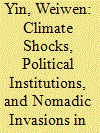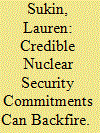|
|
|
Sort Order |
|
|
|
Items / Page
|
|
|
|
|
|
|
| Srl | Item |
| 1 |
ID:
174722


|
|
|
|
|
| Summary/Abstract |
Using a unique pairing of household survey data and geolocational conflict data, we investigate the relationship between conflict intensity and the disciplinary methods employed by Iraqi households. We find that parents in high-conflict areas are more likely to use moderate and severe corporal punishment and are less likely to use constructive parenting techniques like redirection. A corresponding difference-in-differences analysis confirms the nature of this association. While there is a general sense that war has profound long-term impacts on the psychological health of children, research on transmission mechanisms remains limited. Given the persistence of early childhood outcomes into adulthood, these results are potentially an important piece of assessing and mitigating the long-term costs of war on civilian populations.
|
|
|
|
|
|
|
|
|
|
|
|
|
|
|
|
| 2 |
ID:
174721


|
|
|
|
|
| Summary/Abstract |
While a large literature argues negative climate shocks can trigger conflicts, recent findings suggest moderate climatic conditions lead to war. This article proposes a conditional theory by incorporating political institution as a moderating variable. I argue that, under the impact of negative climate shocks, centralized societies can mobilize more resources for war, compared to decentralized societies. Thus, the former is more likely to resort to well-organized plundering to address the scarcity problem caused by detrimental climate shocks. Besides, centralized societies have little incentive to plunder when the climatic conditions are moderate, as they can collect taxes regularly through centralized institutions. A comparison between the more centralized Manchurian and the less centralized Mongols on their conflictual behavior serves as an empirical test. I find that temperature was negatively associated with the probability of Manchurian invasion after they embraced centralization but had a positive effect on the likelihood of Mongol invasion.
|
|
|
|
|
|
|
|
|
|
|
|
|
|
|
|
| 3 |
ID:
174720


|
|
|
|
|
| Summary/Abstract |
How does the alliance between a client state and its nuclear ally influence support for proliferation in the client? Conventional wisdom suggests that when nuclear security guarantees are not credible, support for proliferation will be high, since a domestic nuclear capability offers an alternative source of deterrence. I introduce a new theory, which posits that highly credible security guarantees can backfire by causing some individuals to fear their ally might miscalculate—either by using nuclear weapons in an unnecessary preventative attack or by precipitous escalation of a crisis or conflict. Survey experiments conducted among representative samples of South Korean citizens in 2018 and 2019 support this theory, showing that increases in the credibility of the US nuclear security guarantee lead to increased support for nuclear proliferation among South Korean respondents.
|
|
|
|
|
|
|
|
|
|
|
|
|
|
|
|
| 4 |
ID:
174723


|
|
|
|
|
| Summary/Abstract |
A growing literature identifies both situations where aid promotes peace and those where aid encourages violence. Specifically, research shows lower probability of conflict onset in democratizing states receiving high levels of democracy assistance. However, theorizing has overlooked important actors who have agency in spending such aid: civil society organizations (CSOs). We posit that the status of civil society within recipient states conditions the effect of democracy aid inflows on conflict probability. Using an instrumental variables approach to account for endogeneity between aid allocation and conflict propensity, we find that democracy aid is destabilizing when directed to environments where CSOs are weak and poorly connected to the regime and thus are less willing and able to seek change through peaceful means. When civil society is stronger and more institutionalized, however, larger democracy aid flows pose less threat.
|
|
|
|
|
|
|
|
|
|
|
|
|
|
|
|
| 5 |
ID:
174724


|
|
|
|
|
| Summary/Abstract |
Under what conditions do nonviolent demonstrations escalate to violence? I answer this question using a novel theory of individual impatience in protests that begin peacefully. Rather than considering protest groups as unitary actors, I present a theory of collective action in which a group’s decision over whether or not to engage in anti-government violence is the product of individual preferences. Individuals involved in a nonviolent demonstration use the immediacy of their needs and the sustainability of collective action to decide whether or not to initiate violence against the state. Specifically, I hypothesize that the likelihood of violent escalation will increase when the food price increases and unemployment rate is high or when the event is spontaneous. Analysis of a Bayesian multilevel model of 2,405 nonviolent demonstrations from 1991 to 2017 in Africa and Latin America supports my expectations.
|
|
|
|
|
|
|
|
|
|
|
|
|
|
|
|
| 6 |
ID:
174726


|
|
|
|
|
| Summary/Abstract |
Although often conjectured, there is a lack of empirical evidence whether international inflows of military technology render intrastate conflicts more violent. We address this question and argue that expansions in governments’ ability to fight aggravate the lethality of intrastate war. However, we expect this effect to be conditioned by rebels’ military endowments and their choice of tactics. Where rebels are weak, they avoid open combat, and additional governmental arms imports have no effect on the number of casualties. In contrast, governmental arms imports cause human losses to multiply when rebels have achieved military parity or superiority and, as a consequence, use conventional combat tactics. This hypothesis is tested on the number of battle-related deaths in intrastate conflict, 1989 to 2011, using, for the first time, data on governmental imports of both major conventional weapons and small arms. Results support our propositions and are robust to instrumenting for imports of both types of weapons.
|
|
|
|
|
|
|
|
|
|
|
|
|
|
|
|
| 7 |
ID:
174725


|
|
|
|
|
| Summary/Abstract |
The explosion of cities and megacities has increased scholars’ and policy markers’ attention to the effects such changes might have on conflict: increasingly, urban environments may alter the nature of warfare but not necessarily the incidence of intrastate war. We argue that high levels of urban concentration—the concentration of populations in one or relatively few urban centers—increases both the likelihood of civil wars and their intensity. Urban concentration limits the ability of the state to project power across space, exacerbating grievances in rural areas, easing rebel control of territory, and enhancing their military strength. At the same time, cities become high-value loci of contestation even as urban warfare constrains conventional state military strength. The result is more symmetrical fighting producing more battle deaths. Cross-national regressions show that urban concentration exerts a crucial effect on the likelihood, nature, and intensity of intrastate warfare.
|
|
|
|
|
|
|
|
|
|
|
|
|
|
|
|
|
|
|
|
|